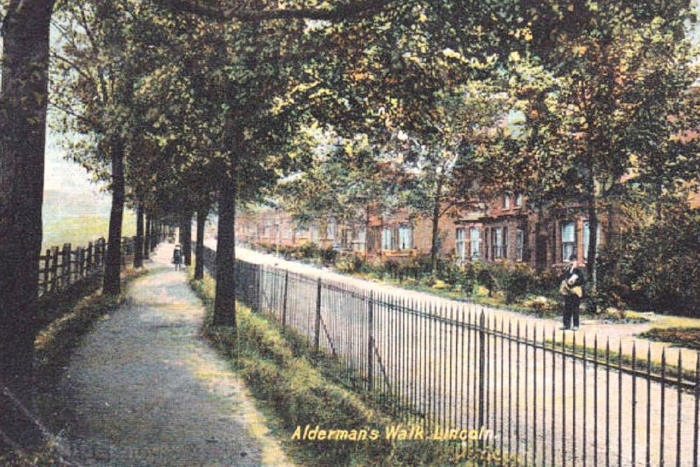
Alderman’s Walk: A Site of Protest
In the latest article highlighting some of the work of The Survey of Lincoln, Andrew Walker examines the history of a city footpath.
On 7 July 1908, a police inspector, police constable, and the city surveyor gathered on Alderman’s Walk, on the eastern edge of the West Common behind numbers 76 and 78 Hewson Road to oversee the erection of a hoarding by the common’s warden and several of his men.
Their purpose was to block two gates giving access to Alderman’s Walk from these properties. The owner, William Kitching, a furniture dealer, had persistently refused to pay the Corporation the annual sum of 2s.6d., which was charged on all properties with direct access to Alderman’s Walk (pictured above circa 1905).
Mr Kitching believed he should not have to pay for entry to what he considered to be a public highway. As work began blocking his gates, Kitching allegedly assaulted the common’s warden and he was locked up until his temper cooled.
Lengthy legal proceedings followed, leading to Mr Justice Joyce’s verdict in the Chancery Division in December 1910 stating that Alderman’s Walk was not a public highway and the Corporation was entitled to charge property owners for access to it. Kitching unsuccessfully challenged the decision in Chancery in May 1911.
Notwithstanding the need to pay small annual sums to enjoy such access, houses bordering Alderman’s Walk proved popular and new properties with back gates leading onto this path and the West Common beyond sold readily during the Edwardian period.
The alderman after whom the walk was named in 1893 was George Glasier. He was a farmer’s son, born in South Hykeham in 1807, and he served in public office, from 1846 until his death, aged 92, in 1900. He was first as Lighting and Paving Commissioner, then a councillor and, from 1877, as an alderman, elected by members of the Council. He was a local businessman, with financial interests in the chemical manure works on Carholme Road, and he was a longstanding director of the Lincoln Corn Exchange and Market Company.
The principal reason for naming Alderman’s Walk after him was because of his commitment to improving the West Common. Glasier campaigned for its better drainage, overseeing the conversion of much swampy land into usable pasture to the south of the grandstand. He was a great champion of the West Common baths, and he laid out a long row of trees along the Fossdyke path to the Pyewipe.
He was also responsible for fencing off land on the east side of the West Common to form the footpath, which was latterly named after him.
The first section of what became Alderman’s Walk was formed in 1885 as part of a public works project, providing short-term work for some of the city’s many unemployed during a deep trade depression. The path initially connected Brickyard Lane (later West Parade) to Carholme Road. This was then extended north, joining Yarborough Road.
Immediately prior to the naming of the path as Alderman’s Walk, discussions had taken place about constructing a road along the route from Carholme Road to Yarborough Road. However, councillors felt that the cost would be excessive, and some freemen and ratepayers, at an indignation meeting in December 1892, protested at the potential loss of a portion of the West Common.
It is interesting to speculate how the residential development of the West End might have been different if a road had been constructed instead of Alderman’s Walk.
The Survey of Lincoln’s book, Lincoln’s West End Revisited, is available in local bookshops, priced £9.50. For more information, see www.thesurveyoflincoln.co.uk.
